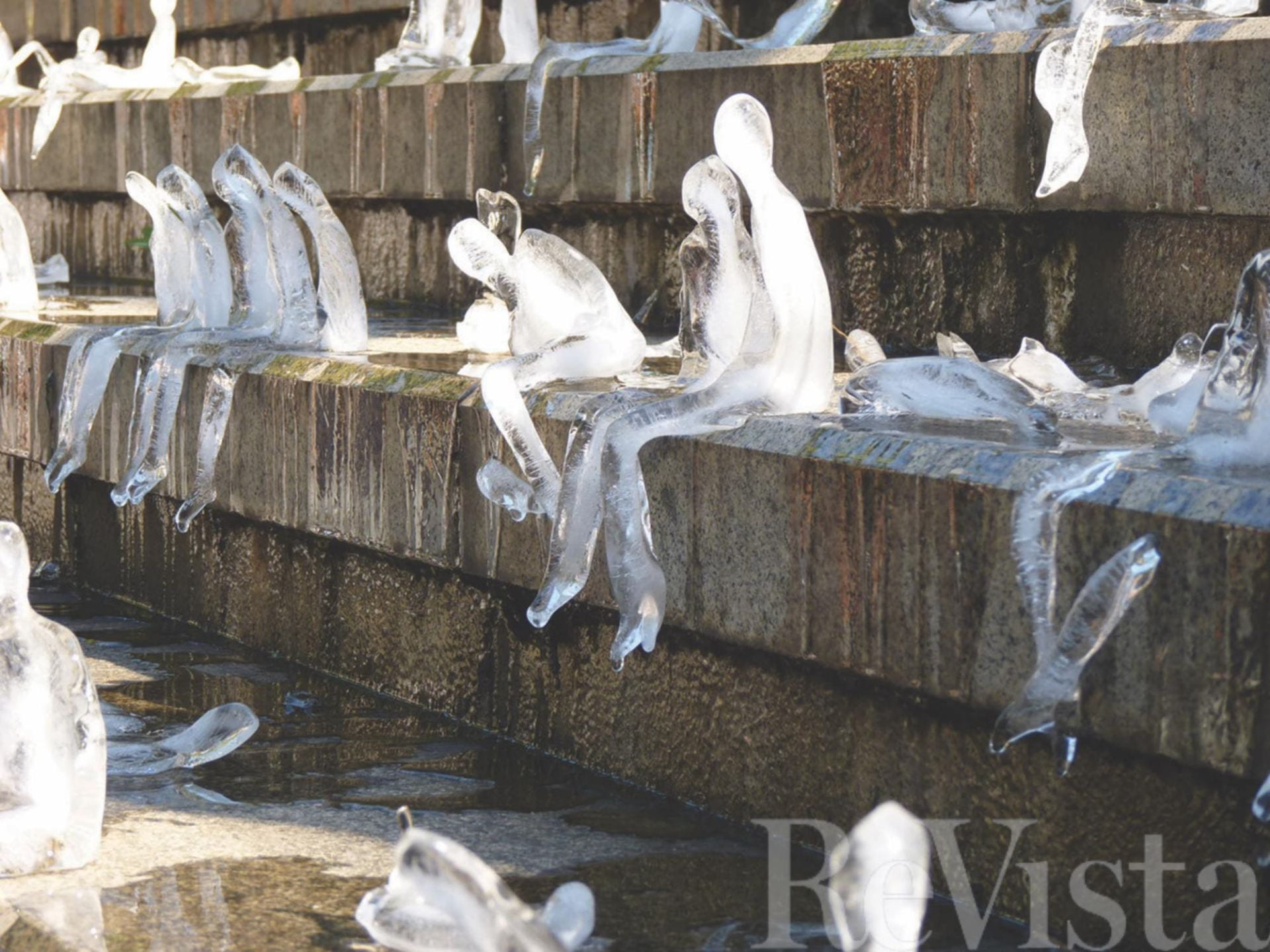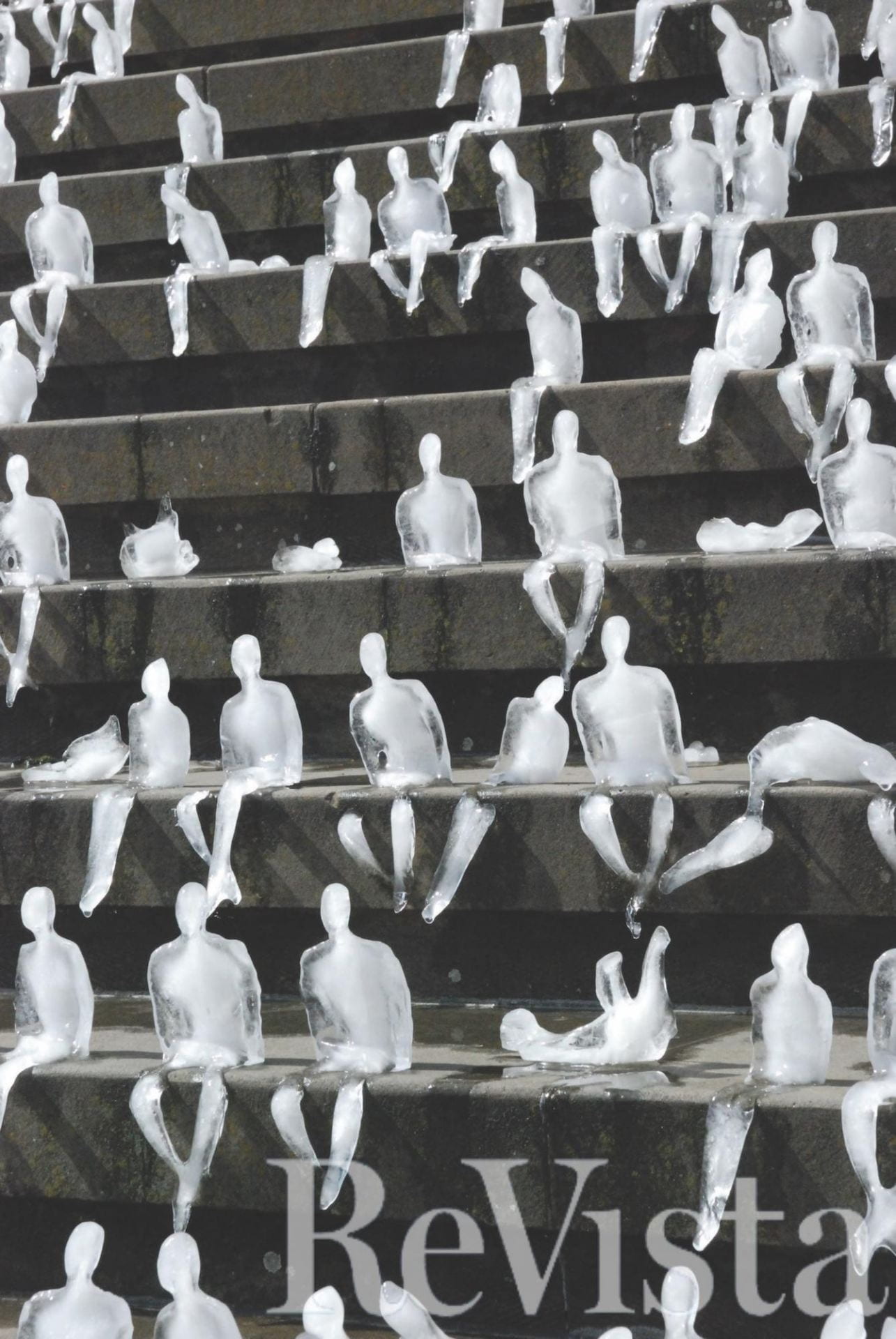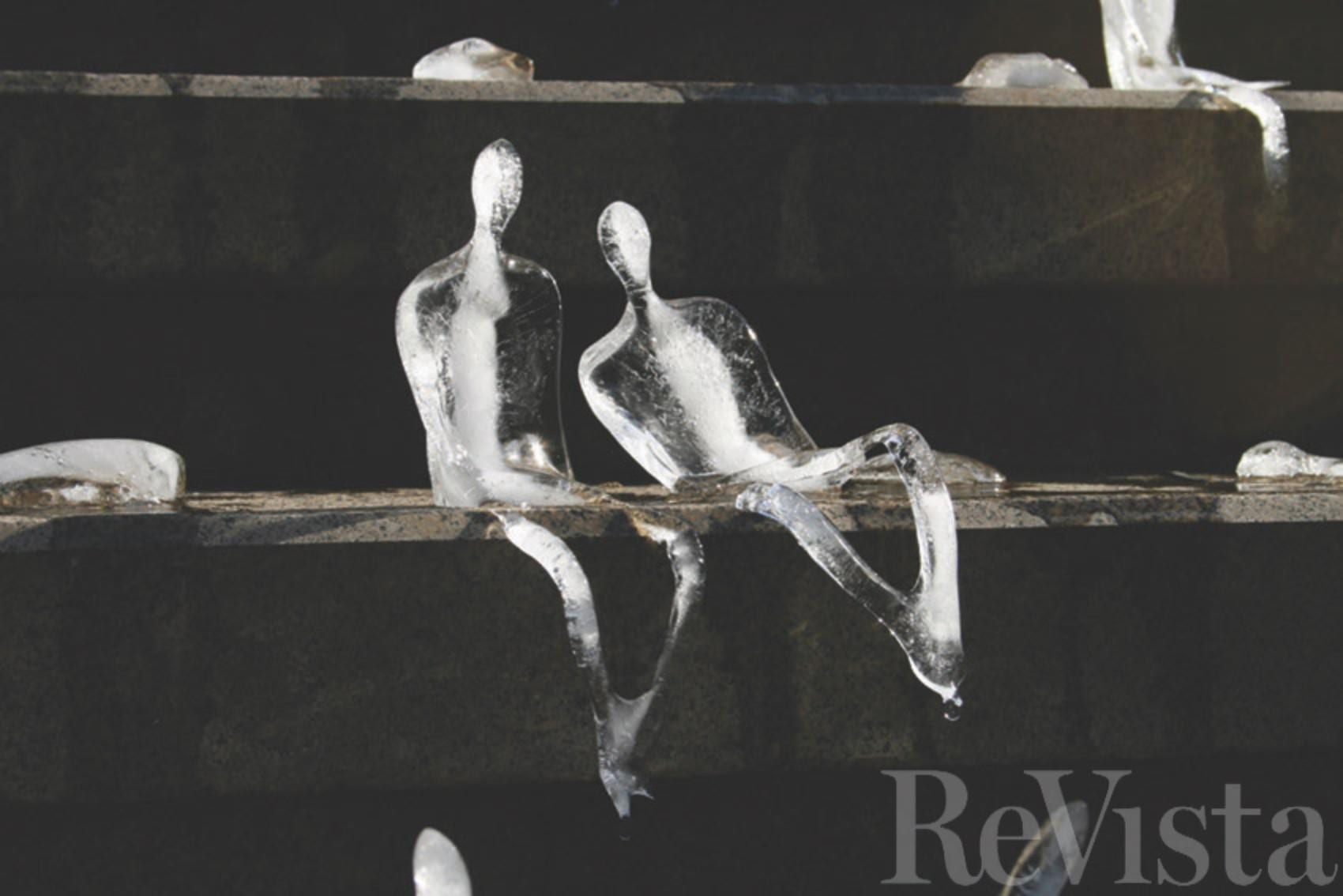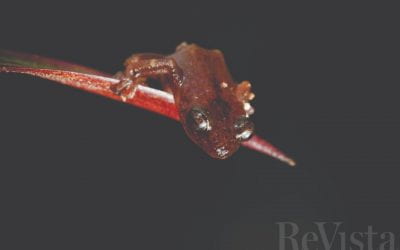The Melting of Humankind
How Art Deepens our Dialogue about Climate Change
Imagine one thousand ice-figurines covering the steps of Berlin’s Gendarmernmarkt Square Concert Hall on a warm September day. Similar scenes had emerged before in cities such as São Paulo, Florence, Havana, Belfast, Tokyo, Paris, Brasilia, Kyoto and Salvador. This artistic installation-cum-urban action titled Monumento Mínimo (Minimum Monument) was the work of Brazilian artist Nele Azevedo. On this occasion, the 73 degrees Fahrenheit temperature turned the melting-men into traceable water marks within thirty minutes and, shortly thereafter, they were gone, leaving no trace of their existence (Azevedo Nele, 2014).
It was the year 2009; the same year that Chacaltaya, the Bolivian glacier that had once housed the world’s most elevated ski resort at 17,785 ft., melted away into nothing but a thin stream of water, a full six years before initially predicted. Chacaltaya also represented a precious fresh water resource for the population of La Paz that, in a matter of months, vanished and dramatically hastened the expected gradual decrease of the mountainous water source. No one had predicted the accelerating effects of rising temperatures or the early disappearance of the glacier that forced Bolivia to declare a state of emergency in January 2016 for the country’s third most populous city (The Guardian, xxviii November 2016).
Chacaltaya is but one example of events that drive the international community of experts’ urgency to develop new collaborative research models that respond to the Special Report on Global Warming of 1.5°C (IPCC 2017). The special report was commissioned by the Intergovernmental Panel on Climate Change (IPCC), following the 2015 United Nations Conference on Climate Change (COP21) or Paris Climate meeting, to establish a basis for understanding the difference of projected impacts and costs between an increase of 1.5°C and 2°C warming. At the same time, the outcome of the glacier’s untimely disappearance is proof that an ethical perspective is necessary, as it can reveal the central role of culture for building the systemic capacity required to adapt to changing conditions.
A powerful environmental thinking flows from the often-paradoxical experience of Latin America, a region rich in diverse forms of practical and adaptive knowledge embedded in traditional cultures, one that is still attuned to the deeply-rooted wisdom of its many identities, and yet cannot escape its indexes of poverty and inequality, or its colonial legacy. The region’s contemporary artistic representation, such as that of Nele Azevedo, is equally powerful; it is as diverse as its peoples and comprises a plurality of aesthetic expressions and cultural relations. Reading these artistic and literary 21st-century works through the lens of ecocriticism, which adopts a humanities perspective to examine paradoxical aspects of human-environment interactions, opens a window onto the complexity of present-day socio-ecological problems. The resulting perspective can facilitate a reevaluation of environmental problems that reveals their fundamentally ethical nature in and far beyond Latin America.
The world’s changing climate and the need to respond to the outcomes of the Paris Climate meeting of 2015 was also raised from the outset at a summer meeting of the U.S. National Council on Science and the Environment that I attended in June 2017. One of the meeting’s primary aims was to highlight current goals and trends regarding the future of environmental and sustainability work in higher education, including what it means to engage this topic in anticipation of future adaptations. The challenge was not just to establish understanding of complex differences between magnitudes of warming, but to do so within the context of the 2015 Sustainable Development Goals (SDGs) that underpin the UN 2030 Sustainable Development Agenda (UN Sustainable Development Goals, 2015). This discourse exuded an urgency to engage with United Nations work, and to creatively and collectively identify the kind of research and collaboration necessary, given a paucity of peer-reviewed literature upon which to evaluate the difference of impacts and costs between 1.5°C and 2°C warming (Liverman, Diana, NCSE summer meeting, 2017).
Here we were, in 2017, looking at a set of Sustainable Development Goals that were agreed to in 2015 and delineated an agenda for the world in ways that seemed to usher in a new rhetoric, but notably shared the underlying rationale of the objectives delivered at the seventh meeting of Ministers of the Environment of Latin America and the Caribbean, held in São Paulo, Brazil, in 2002 (Manifesto). These objectives would coalesce into a manifesto, a Latin American manifesto of Latin American environmental thinking that represented the collective will to understand and respond to the challenges that would later be put forth in the SDGs. This was theMANIFESTO FOR LIFE in Favor of an Ethic for Sustainability (UNEP Latin America 2003), or a manifesto of an ethic in favor of life.
In this light, one could argue that the so-called environmental crisis which afflicts the world today is symptomatic of another major crisis: a crisis of modern knowledge. What are the singular challenges that climate change poses to that knowledge and to our global modernity? What are the unique ways in which Latin American thinking makes sense of those challenges? How do these ways of knowing and making meaning contribute to international conversations about climate and global change? These questions define an endeavor that is both practical and epistemological. Responses to that challenge must equally involve perspectives from the ecological sciences and the arts and humanities, an assertion that directly aligns with the International Council for Science’s recent assessment of the 2015 United Nations Sustainable Development Goals, which underscores the necessity of an integrated approach for dealing with our changing climate (ICS Report, May 2017).
Here, the humanities provide vital insights of culture, human institutions and practical wisdom. In other words, the humanities provide deep readings of texts and signs that enable the interrogation of human values and actions, which in turn deepen our understanding of the range and diversity of human knowledge available to us, enabling us to respond to these critical issues. For example, an approach to water and food access that focused exclusively on management and agro-technical aspects, without addressing the fact that women, worldwide, provide approximately eighty per cent of the world’s food supply and at the same time are the majority of the world’s poor, would fail to understand that this is as much a gender issue as it is a socio-economic and technical one. And this is where art and the humanities have the special ability to establish a perspective that encompasses the full complexity of socio-ecological challenges.
The thousands of faceless tiny men and women sculpted in ice by Nele Azevedo, that wandered between the public stairways of cities, states and countries, and intervened in both their physical and discursive urban landscapes, have continued to spark conversations about climate change. Since 2001, the presence of these works has suspended daily routines, transforming the public space in unique ways and altering culturally contoured norms and behavior that we naturalize in our daily life. Azevedo’s arranging of her 500, 1,000 or 5,000 sculptures is always a community event. She invites the public to partake in assembling the installation, but surprises the observer with a kind of social happening. The miniature icy bodies are placed in position by volunteers, often casual passersby, turning each sculpture’s placement into something very personal—a personal moment of contact with an icy-cold reflection of ourselves, that will soon become part of a sea of anonymity.
Her sculptures and installations, by their very nature as objects, reconfigure and re-functionalize the space where they are placed. But space is hardly neutral. To intervene in public space is to challenge the limits of that space, and of what is public and of the subjective knowledge stored in it. Part of that subjective knowledge that is naturalized in our modern urban daily life, manifests in an often-indifferent behavior toward public spaces that has become deeply ingrained within society, consciously or otherwise. Azevedo is aware of this social performance when she situates her melting-menon an urban monument and metaphorically intercepts the site and its memory with a sensory experience involving ice. For the viewer, the faceless bodies and ephemeral ice figures soon become a confrontation of our modern indifference and the fragility of our existence, at the same time. They are also an honest representation of the beauty of the ordinary, which interrogates the ethics of a contemporary experience that is constantly choreographed in relation to consumer images, slogans and individualistic practices. Azevedo’s Minimum monument reminds us of the forgotten bodies that surround us in a shared planet, common to us all.
The dynamic experience with this art installation begins as the figurines melt. The once collective presence of the thousand turns into the daunting disappearance of fallen bodies, as ghostly figures melt under a watchful audience, much like Chacaltaya did under eyes of the Bolivian population. Although originally intended to examine the role of monuments in the contemporary city, Azevedo’s ice sculptures now speak of global warming as a threat to life:
The ice gave poetic support to what I was looking for. I wanted to break the characteristics of the monument. Curiously, monuments in antiquity were made to remember that people die. As today in the capitalist system the “dead” do not produce wealth, the dead do not enter into the “account.” But we are still mortals. By affinity, I was invited to work on environmental issues. My work was considered by many as an alert to global warming and I accepted that affinity, because it is our life that is threatened. The planet will continue to exist, but our life that is threatened. I do not know if we still have time to reverse it, but I hope we have time. (Azevedo 2014, my translation)
Indeed, global change is increasingly understood as a systemic, eco-social challenge that requires a deeper capacity to foster leadership and responses to both local and regional problems for working across boundaries and differences, from diverse disciplines and methods, to identities and cultures, and other ways of knowing the world. The 2002 Manifesto for Life issued by Latin America and the Caribbean’s Ministers of Environment defined these needs and centered discussion of climate and environmental change around ethics: “an ethic of knowledge and dialogue among fields of knowledge, an ethic for global citizenship, an ethic of global governance and participatory democracy, of peace and dialogue for resolving problems, of rights, justice and democracy for the commons and the common good” (Manifesto). It explained our current climate and environmental crisis from an ethical perspective, revealing the central role played by culture as a tool for building the systemic capacity to evolve with changing conditions. Not only is the manifesto a clear sign of the contributions that a uniquely Latin American environmental thinking can make to international conversations about climate and global change, it also functions as a road map for engaging the topics enunciated through the SDGs from multiple viewpoints, including the arts, the humanities and the traditional knowledge that embeds much of the regions’ own ecological potential (Leff, E. “Latin American Environmental Thinking: A Heritage of Knowledge for the Humanities,” 2012).
As an aesthetic experience that is both social and emotional, Minimum Monument fosters a kind of dialogue that is still infrequent in discussions about climate change. The transformational and disquieting aesthetic of a melting humankind forces the observer, even if only for an instant, to ask the why of the installation. It is here that its ephemeral quality creates a visual image capable of confronting the ethics (or the lack of ethics) sustained by the many abstractions of today’s globalized world, including those leading to frequent inaction to engage in climate action. The installation functions as a cultural mirror, or a collective cultural reflection of ethics and values. Moreover, the melting men’s success at making visible issues of temporality serves as a reminder of what Rob Nixon has called the “slow violence” of environmental change.
This is a violence that confronts the fast-paced, detached worldview perpetuated by mainstream media, with its discardable facts once their news value has been extracted. It is the violence of “disasters that are slow-moving and long in the making, anonymous, starring nobody, attritional and of indifferent interest to our image driven world” (Nixon, R. Slow Violence and the Environmentalism of the Poor, 2011). When overwhelming evidence of the ecological disruptions, climate change, resource depletion, and urban growth causes a devastating alarm that leaves the public’s imagination with a sense of powerlessness, experiences such as that of Azevedo’s art work stimulate a powerful discourse that is necessary, both consciously and subconsciously. Her installations are situated in dialogue with the environment and the community. Her aesthetic language personalizes experience of place and adds a humane dimension to the global conflict of a warming planet. She brings visibility to important issues and, while the dialogue may have a beginning and an end, the meaning that is produced lives on.
Spring/Summer 2018, Volume XVII, Number 3
Maria Alessandra Woolson teaches at the University of Vermont for the College of Arts and Sciences and the Honors College, and is an affiliate of its GUND Institute for Environment. Her teaching and scholarship bring together the worldviews of science and humanities, framed by sustainability as a paradigm for interdisciplinary studies in the context of Latin America. Her research interests and publications include transcultural perspectives in Ecocriticism, the culture of water and water governance, digital humanities, and biocultural diversity as an empirical approach to the study of identity and conservation.
Related Articles
The Brave New World of the Digital Herbarium
Here in the northeast of the United States, spring will soon be upon us, pulling us from the darkness and cold of winter’s grip. Spring’s exuberance—singing and nesting birds returning from
Writing at the End of the World: Mayra Montero’s In the Palm of Darkness
Mayra Montero’s In the Palm of Darkness (Tú, la oscuridad, 1995) takes us on an in-depth journey that allows us to understand relationships between the crises caused by climate change and
The Parrots of the Caribbean
I ask you, for a few moments, to imagine a Caribbean region where you can suddenly be rendered breathless by the sight of a flock of a thousand Amazona parrots flying overhead, darkening the skies like a gaily colored, deafeningly squaking eclipse of joy…







